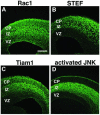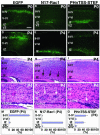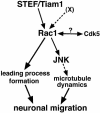The in vivo roles of STEF/Tiam1, Rac1 and JNK in cortical neuronal migration
- PMID: 12912917
- PMCID: PMC175802
- DOI: 10.1093/emboj/cdg413
The in vivo roles of STEF/Tiam1, Rac1 and JNK in cortical neuronal migration
Abstract
The coordinated migration of neurons is a pivotal step for functional architectural formation of the mammalian brain. To elucidate its molecular mechanism, gene transfer by means of in utero electroporation was applied in the developing murine brain, revealing the crucial roles of Rac1, its activators, STEF/Tiam1, and its downstream molecule, c-Jun N-terminal kinase (JNK), in the cerebral cortex. Functional repression of these molecules resulted in inhibition of radial migration of neurons without affecting their proper differentiation. Interestingly, distinct morphological phenotypes were observed; suppression of Rac1 activity caused loss of the leading process, whereas repression of JNK activity did not, suggesting the complexity of the signaling cascade. In cultured neurons from the intermediate zone, activated JNK was detected along microtubules in the processes. Application of a JNK inhibitor caused irregular morphology and increased stable microtubules in processes, and decreased phosphorylation of microtubule associated protein 1B, raising a possibility of the involvement of JNK in controlling tubulin dynamics in migrating neurons. Our data thus provide important clues for understanding the intracellullar signaling machinery for cortical neuronal migration.
Figures








Similar articles
-
Roles of STEF/Tiam1, guanine nucleotide exchange factors for Rac1, in regulation of growth cone morphology.Mol Cell Neurosci. 2003 Sep;24(1):69-81. doi: 10.1016/s1044-7431(03)00122-2. Mol Cell Neurosci. 2003. PMID: 14550769
-
Characterization of STEF, a guanine nucleotide exchange factor for Rac1, required for neurite growth.J Biol Chem. 2002 Jan 25;277(4):2860-8. doi: 10.1074/jbc.M106186200. Epub 2001 Nov 13. J Biol Chem. 2002. PMID: 11707441
-
The guanine nucleotide exchange factor Tiam1: a Janus-faced molecule in cellular signaling.Cell Signal. 2014 Mar;26(3):483-91. doi: 10.1016/j.cellsig.2013.11.034. Epub 2013 Dec 2. Cell Signal. 2014. PMID: 24308970 Review.
-
Expression of stef, an activator of Rac1, correlates with the stages of neuronal morphological development in the mouse brain.Mech Dev. 2002 Apr;113(1):65-8. doi: 10.1016/s0925-4773(01)00650-5. Mech Dev. 2002. PMID: 11900975
-
Activation mechanism and physiological roles of stress-activated protein kinase/c-Jun NH2-terminal kinase in mammalian cells.J Biol Regul Homeost Agents. 2003 Oct-Dec;17(4):295-302. J Biol Regul Homeost Agents. 2003. PMID: 15065757 Review.
Cited by
-
Kalirin-RAC controls nucleokinetic migration in ADRN-type neuroblastoma.Life Sci Alliance. 2021 Mar 3;4(5):e201900332. doi: 10.26508/lsa.201900332. Print 2021 May. Life Sci Alliance. 2021. PMID: 33658318 Free PMC article.
-
Application of in utero electroporation and live imaging in the analyses of neuronal migration during mouse brain development.Med Mol Morphol. 2012 Dec;45(1):1-6. doi: 10.1007/s00795-011-0557-0. Epub 2012 Mar 20. Med Mol Morphol. 2012. PMID: 22431177 Review.
-
Advances in Understanding the Molecular Mechanisms of Neuronal Polarity.Mol Neurobiol. 2023 May;60(5):2851-2870. doi: 10.1007/s12035-023-03242-w. Epub 2023 Feb 4. Mol Neurobiol. 2023. PMID: 36738353 Review.
-
Coupling neurotrophins to cell migration through selective guanine nucleotide exchange factor activation.Proc Natl Acad Sci U S A. 2005 Apr 19;102(16):5645-6. doi: 10.1073/pnas.0501718102. Epub 2005 Apr 12. Proc Natl Acad Sci U S A. 2005. PMID: 15827113 Free PMC article. No abstract available.
-
Involvement of a Rac activator,P-Rex1, in neurotrophin-derived signaling and neuronal migration.J Neurosci. 2005 Apr 27;25(17):4406-19. doi: 10.1523/JNEUROSCI.4955-04.2005. J Neurosci. 2005. PMID: 15858067 Free PMC article.
References
-
- Bulinski J.C. and Gundersen,G.G. (1991) Stabilization of post-translational modification of microtubules during cellular morphogenesis. BioEssays, 13, 285–293. - PubMed
-
- Cheng A., Krueger,B.K. and Bambrick,L.L. (1999) MAP5 expression in proliferating neuroblasts. Brain Res. Dev. Brain Res., 113, 107–113. - PubMed
-
- Derijard B., Hibi,M., Wu,I.H., Barrett,T., Su,B., Deng,T., Karin,M. and Davis,R.J. (1994) JNK1: a protein kinase stimulated by UV light and Ha-Ras that binds and phosphorylates the c-Jun activation domain. Cell, 76, 1025–1037. - PubMed
Publication types
MeSH terms
Substances
LinkOut - more resources
Full Text Sources
Molecular Biology Databases
Research Materials
Miscellaneous

